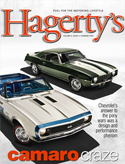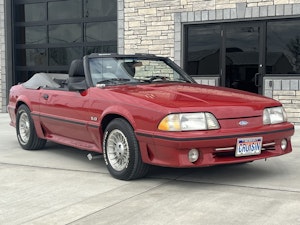Media | Articles
Nice Guys Always Finish First
Former concours chairman Larry Smith has built a serious collection in his own right.
Go to many concours in the United States and you’ll see a tall man with graying hair and a neatly trimmed mustache. Sometimes he’ll be showing a car; possibly his Stout Scarab or supercharged Swiss-bodied Graham. Other times he’ll be judging cars or automotive art. If you’re at the Meadow Brook Concours d’Elegance, Larry Smith is even more visible.
Smith first became involved with the Rochester, Michigan-based event in the early 1980s as an advertiser. Soon, he joined as both a committee member and art show chair (he collects automotive art), ultimately assuming the show’s reins in 2007 when Meadow Brook Concours d’Elegance founder and chair Don Sommer stepped down. Although Smith himself stepped down as chairman in late 2008, he remains committed to the event and the collector car hobby. He currently has more than 35 cars in his collection, many of which he keeps in a dedicated garage at his home in Bloomfield Hills, Michigan.
LEARNING THE BUSINESS
When Smith was 6 months old, his family moved from Illinois to the modest part of Grosse Pointe, Michigan, so he could attend the area’s acclaimed schools. However, Smith didn’t have much interest in academics – and it showed in his grades. “For me, high school was a place to look at girls and think about cars,” he says.
Marketplace
Buy and sell classics with confidence
In his early teens, Smith had graduated from drawing cars to building plastic models, foreshadowing his future career. “I’d heat them up and push a couple together to simulate car crashes,” he says. “The models gave way to mini bikes and go carts, all of which I either built or modified.”
Smith was 16 when he dragged home a 1957 Triumph TR3. “It was an old piece of junk,” he says. “I took it apart and rebuilt the engine. But it never ran until I became friends with Dan Hill, the mechanic at Eastern Sports Cars.”
With Hill’s help, Smith secured a part-time position as a porter at the local dealership, although he still was fixing up old cars at home. He soon turned to body repairs, which he claims were “pretty ugly” until his boss, Ken Becker, took the time to teach him the proper techniques.
After high school, Smith attended junior college for two years and went on to study anthropology at Wayne State University in Detroit. “After a year, I realized I’d never be happy unless I was doing something with cars,” Smith says. Before long he was back at Eastern Sports Cars as a mechanic, soon transitioning to a full-fledged body technician.
Realizing that there was no future for him at a family-run shop, Smith made a bold move in September 1975 when he rented an old service station in Center Line, Michigan. With just his tools and $2,000, the 24-year-old opened a body repair shop for foreign cars, naming it Autometric Collision.
For years, Smith worked 16 to 18 hours, seven days a week. “My dog didn’t even recognize me because I was never home,” he says. Customers were lining up for Smith’s services, with some even waiting seven weeks. He opened additional shops to reduce waiting times and make room for Autometric’s best employees to grow within the company.
Smith eventually left the shop floor and, with the help of many courses and the right advisors – most encountered through repairing and collecting cars – he learned how to manage what’s now a multimillion-dollar company with seven locations throughout metro Detroit.
THE SPOILS OF SUCCESS
These days, Smith’s busy schedule leaves him little time to tinker with his own cars. But one advantage of owning seven body shops is that he never has a problem finding someone to help with a car restoration – although Smith’s cars are the only ones Autometric restores. “Restoration and collision work appear similar, but they really don’t mix,” Smith says. “It’s difficult to make a profit doing collision repairs and nearly impossible in the restoration business.”
He dreams of taking off several months to restore one of his own cars, but knows it’s just not a reality. “I’m too busy with family commitments and running the business,” he says.
In fact, Smith has been so busy that he had no idea he’d gotten up to 35 cars until he recently counted them. His collection includes great marques like Bugatti, Ferrari, Jaguar and Porsche, but also Willys, Chevrolet, Ford, Fiat and Triumph. Drivability and proportion strongly influence his choices. He also likes cars he can actually use, which is why he recently sold a Ferrari 275 GTB that had become “too valuable” to enjoy.
Smith’s wish list includes a Riley MPH, Ferrari Daytona, Maserati Ghibli and a 1940 Ford Coupe. “I’d also love some other Ferraris as well as something with Figoni & Falaschi coachwork,” he says. “But before that happens, Autometric Collision will have to repair a lot more BMWs, Mercedes and Hondas.”
***
To see this article in its original format, view the pdf version of the Summer 2009 issue of Hagerty magazine.










